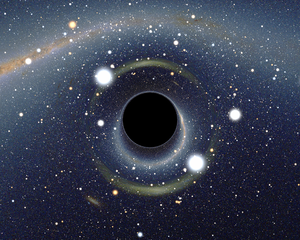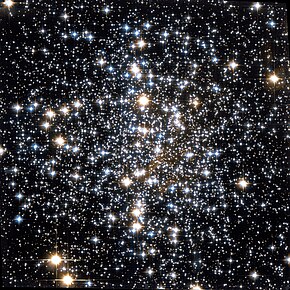IntroductionA star is a luminous spheroid of plasma held together by self-gravity. The nearest star to Earth is the Sun. Many other stars are visible to the naked eye at night; their immense distances from Earth make them appear as fixed points of light. The most prominent stars have been categorised into constellations and asterisms, and many of the brightest stars have proper names. Astronomers have assembled star catalogues that identify the known stars and provide standardized stellar designations. The observable universe contains an estimated 1022 to 1024 stars. Only about 4,000 of these stars are visible to the naked eye—all within the Milky Way galaxy. A star's life begins with the gravitational collapse of a gaseous nebula of material largely comprising hydrogen, helium, and trace heavier elements. Its total mass mainly determines its evolution and eventual fate. A star shines for most of its active life due to the thermonuclear fusion of hydrogen into helium in its core. This process releases energy that traverses the star's interior and radiates into outer space. At the end of a star's lifetime as a fusor, its core becomes a stellar remnant: a white dwarf, a neutron star, or—if it is sufficiently massive—a black hole. Stellar nucleosynthesis in stars or their remnants creates almost all naturally occurring chemical elements heavier than lithium. Stellar mass loss or supernova explosions return chemically enriched material to the interstellar medium. These elements are then recycled into new stars. Astronomers can determine stellar properties—including mass, age, metallicity (chemical composition), variability, distance, and motion through space—by carrying out observations of a star's apparent brightness, spectrum, and changes in its position in the sky over time. Stars can form orbital systems with other astronomical objects, as in planetary systems and star systems with two or more stars. When two such stars orbit closely, their gravitational interaction can significantly impact their evolution. Stars can form part of a much larger gravitationally bound structure, such as a star cluster or a galaxy. (Full article...) Selected star - Photo credit: User:Mysid VY Canis Majoris (VY CMa) is a red hypergiant star located in the constellation Canis Major. One of the largest stars and also one of the most luminous of its type, it has a radius of approximately 1,420 ± 120 solar radii (equal to a diameter of 13.2 astronomical units, or about 1,976,640,000 km), and is situated about 1.2 kiloparsecs (3,900 light-years) from Earth. VY CMa is a single star categorized as a semiregular variable and has an estimated period of 2,000 days. It has an average density of 5 to 10 mg/m3. If placed at the center of the Solar System, VY Canis Majoris's surface would extend beyond the orbit of Jupiter, although there is still considerable variation in estimates of the radius, with some making it larger than the orbit of Saturn. The first known record of VY Canis Majoris is in the star catalogue of Jérôme Lalande, on March 7, 1801. The catalogue listed VY CMa as a 7th magnitude star. Further studies on its apparent magnitude during the 19th century showed that the star has been fading since 1850. Since 1847, VY CMa has been known to be a red star. During the 19th century, observers measured at least six discrete components to VY CMa, suggesting the possibility that it is a multiple star. These discrete components are now known to be bright areas in the surrounding nebula. Visual observations in 1957 and high-resolution imaging in 1998 showed that VY CMa does not have a companion star. Selected article - Photo credit: User:Alain r According to the general theory of relativity, a black hole is a region of space from which nothing, including light, can escape. It is the result of the deformation of spacetime caused by a very compact mass. Around a black hole there is an undetectable surface which marks the point of no return, called an event horizon. It is called "black" because it absorbs all the light that hits it, reflecting nothing, just like a perfect black body in thermodynamics. Under the theory of quantum mechanics black holes possess a temperature and emit Hawking radiation. Despite its invisible interior, a black hole can be observed through its interaction with other matter. A black hole can be inferred by tracking the movement of a group of stars that orbit a region in space. Alternatively, when gas falls into a stellar black hole from a companion star, the gas spirals inward, heating to very high temperatures and emitting large amounts of radiation that can be detected from earthbound and Earth-orbiting telescopes. Astronomers have identified numerous stellar black hole candidates, and have also found evidence of supermassive black holes at the center of galaxies. After observing the motion of nearby stars for 16 years, in 2008 astronomers found compelling evidence that a supermassive black hole of more than 4 million solar masses is located near the Sagittarius A* region in the center of the Milky Way galaxy. Selected image - Photo credit: NASA/WikiSky Messier 4 or M4 (also designated NGC 6121) is a globular cluster in the constellation of Scorpius. It was discovered by Philippe Loys de Chéseaux in 1746 and catalogued by Charles Messier in 1764. It was the first globular cluster in which individual stars were resolved. Did you know?
SubcategoriesTo display all subcategories click on the ► Selected biography - Photo credit: Unknown artist, uploaded by User:Salvatore Ingala Claudius Ptolemaeus (Greek: Κλαύδιος Πτολεμαῖος Klaúdios Ptolemaîos; c. AD 90 – c. 168), known in English as Ptolemy /ˈtɒləmɪ/, was a Roman citizen of Egypt who wrote in Greek. He was a mathematician, astronomer, geographer, astrologer and a poet of a single epigram in the Greek Anthology. He lived in Egypt under Roman rule, and is believed to have been born in the town of Ptolemais Hermiou in the Thebaid. He died in Alexandria around AD 168. Ptolemy was the author of several scientific treatises, at least three of which were of continuing importance to later Islamic and European science. The first is the astronomical treatise now known as the Almagest (in Greek, Ἡ Μεγάλη Σύνταξις, "The Great Treatise", originally Μαθηματικὴ Σύνταξις, "Mathematical Treatise"). The second is the Geography, which is a thorough discussion of the geographic knowledge of the Greco-Roman world. The third is the astrological treatise known sometimes in Greek as the Apotelesmatika (Ἀποτελεσματικά), more commonly in Greek as the Tetrabiblos (Τετράβιβλος, "Four Books"), and in Latin as the Quadripartitum (or "Four Books") in which he attempted to adapt horoscopic astrology to the Aristotelian natural philosophy of his day. In Almagest, considered to be one of the most influential scientific texts of all time, Ptolemy presented his astronomical models in convenient tables, which could be used to compute the future or past position of the planets. The Almagest also contains a star catalogue, which is an appropriated version of a catalogue created by Hipparchus. His Planetary Hypotheses went beyond the mathematical model of the Almagest to present a physical realization of the universe as a set of nested spheres. TopicsThings to do
Related portalsAssociated WikimediaThe following Wikimedia Foundation sister projects provide more on this subject:
Discover Wikipedia using portals |
The Stars Portal
























